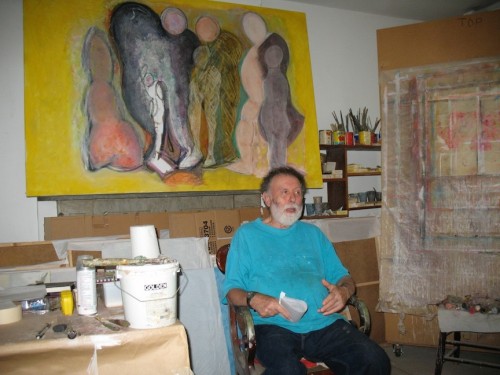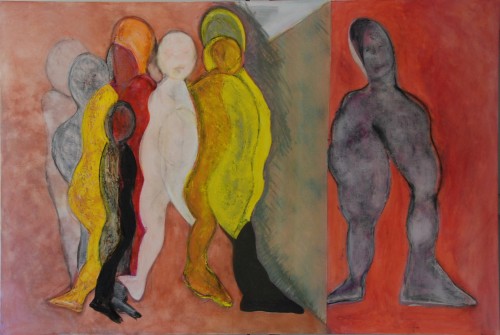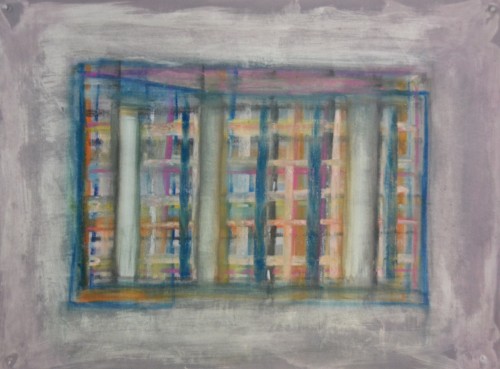Cleaning closet and old files, and here emerges a pamphlet with text on Basil’s art by Fielding Dawson, written twenty-five years ago. The pamphlet accompanied “Paintings from the Cards,” an exhibition of Basil King’s work at Steve Clay’s first New York City shop, Granary Books, 636 Broadway—September 21-October 20, 1989.
There were eleven paintings in the show, all oil on canvas, all done between 1985 and 89, and none captured by digital photographs. There are slides. And the paintings themselves are in storage at Crozier Newark.
Twenty-five years ago, Fielding (and Basil) attributed his angle of vision to a birth accident – as once again we’re doing in re Baz’s spinal-fluid gap (aka salt water ocean) in his right brain – and the amazing overgrowth of his left brain.
Good to know that today’s neuroscientists have debunked the old left brain/right brain dichotomy. (Left being intuitive, inventive, open to the subconscious and Right being bookkeeper, analyst, grammarian, mathematician.) Instead it’s rosy grey all over with many ways and means to cross talk.
None of that is as interesting as the insight Fielding had on Baz’s paintings which holds up years after Fee left us. AND in language with punctuation that uncannily captures Fee’s unique vocal presence. It’s as if Fee himself emerged out of that old filing cabinet. Scroll down for Fee’s essay!



On Basil King’s Paintings – Fielding Dawson
Early work, in an artist’s life, is predictive.
Later, mature work, is reflective, in particular if it’s original.
It is in retrospect we see first clues to the genius of Pollock in that first, small self portrait…more of the same, but as none other, of Mozart, in his first symphony, written at eight, which we hear throughout the piano concertos and in the final work of work, the unfinished Requiem.
And once in a while we’re lucky to have a mature and original artist whose most recent work reflects not only the entire body of his work, but himself as well. I’ve known Basil since we met at Black Mountain, 1951 or so, so these words are from experience, as well as ideas.
His work is meant to be seen before it is judged, just like Van Gogh’s. Or Soutine. Look at it, see what you see. This work speaks its own story because it’s involved with style. The way paint is applied is the style of his visions (not true of dozens of painters, from Hals to Rothko: where paint is the medium toward impact). Basil’s figures are painted on, they do not emerge through. He’s an illustrator after appearances, illustrating what he wants but we might not want, to see. This work reflects his point of view his way: he’s the artist, not the apologist.
The responsibility of seeing art is also in the viewer, and here—perhaps as always—to forget Rembrandt and look at Rembrandt’s work, see what you see, if we forget about who painted these paintings, and concentrate on the work, a good understanding is possible.
These odd diffuse presences, on their flat netherworld surfaces: classical shades near the River Styx, silent in their infinite, in part Surreal elongations and distortions—bodies unlike familiar bodies, heads unlike familiar heads, faces and expressions unlike oh ANYTHING as we know it! For in our Western world it all becomes subjective, while pretty still lifes and landscape posters from the Met and the Louvre, like advertising not an inherent part of our lives, but like Impressionism in clever hands, are preferred, attractive and recognizable, these even beautiful images we imagine are part, perhaps denied, but part of our lives, in an inner, romantic way. Beauty as inner experience, preferred and enjoyable we wish—WISH! DREAM it to be imbued in us which thereby we pray it becomes REAL, and we do pray. A subjective prayer toward what the media and the cultured art world have assumed is proper, and nice.
We don’t know how brainwashed we are until we see original work like this, that reaches in, grabs hold, and gives our senses a good rattle.
No matter what we do with it, art was, is and will never be any one way. It is the one experience of humankind where all the rules can be broken and it will survive, healthy and of its own, intact. And, like nature, it reflects the artist by casting in its reflective way light on aspects of a potential sphere of action many are not aware of, or are aren’t sure…if all things are taken into consideration—brushstroke, size of canvas—all things (his awareness of the edge of the canvas), open all the doors (all his colors appear mixed no use of the primaries), and the artist—with an interested onlooker only an elbow away—will see the inevitable image or composition that is beyond his control but is yet a great part of his life, which so few artists admit: this other face, or image—identity, that so few painters confront but is such a part of the dynamo…in his concoction where behind his eyes a blend results in a visual transfer of identity to emerge complete with a point of view not unlike, if we put aside Stevenson’s theatrical lab work, born all over again: Mister Hyde the artist.
Who might regard these paintings as the result of a collective Eyes Closed effort, a stylized pictorial range of human shapes and configurations ignored, if not avoided, but which are with us still and in great numbers there, in Hiroshima, and Nagasaki, so near Chernobyl and Three Mile Island, in the blood of Agent Orange children painted through, not from, right through Ethan Allen interiors: through the false color of color television: on opaque backgrounds, foreground image-figures, cartoons, alive by a will greater than their own.
The artist possessor of that will discovered of recent (how old is Basil, fifty-four?), and in conversation in his studio this summer, said that after lifelong upper back problems—causing a slight difference in posture—he saw yet one more in an endless chain of doctors who, with his hands on Basil’s back, asked, had Basil been born in Caesarian birth? Yes. Well, this medical gentleman said, he had been lifted out at the wrong angle, causing the spine…on the first day in the world, of the man who painted these paintings.
Fielding Dawson,well-known for his superb short stories, novels and memoirs, is an artist as well, whose collages and drawings have been widely published.

Lori
Happy Birthday, Basil!!!